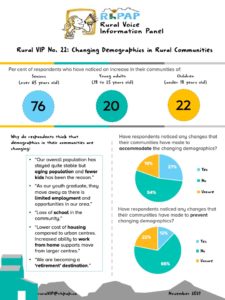Demographic statistics show that seniors (those 65 or older) are the fastest growing population in rural Alberta; however, not all rural communities are the same, and some rural communities may find that their population is getting younger instead of older.
The general trend towards an aging population can be due to several reasons, such as older people choosing to retire in rural communities or younger people leaving for school or to pursue career options. Regardless of the reasons, communities must adapt to their changing demographics. For example, communities with a growing number of seniors will need more programs to support those seniors.
For this month’s Rural VIP survey, we asked participants about changes to demographics that they have noticed in their community.
Key findings
Three quarters of respondents have noticed an increase in the population of seniors in their communities over the last ten years. Respondents are twice as likely to have noticed a decrease in the proportion of young adults and children in their community than to have noticed an increase. Respondents attribute this change to many different factors, including residents having fewer children, lack of employment opportunities for young adults, and seniors moving to their community to retire.
A quarter of respondents have indicated that their community has made changes to accommodate their changing demographics. Examples given of these changes include increased activities and programs to assist seniors. One respondent even noted that their community has a part-time “senior advisor” working for the town who helps connect seniors with services.
Only 12 per cent of respondents indicated that their community has made changes to prevent shifting demographics. Examples given for these changes include introducing scholarship and bursary programs for students, launching advertising campaigns to attract families, and encouraging business development in the community.
Since the COVID-19 pandemic began in March 2020, many businesses and schools shifted to work or learn from home models, allowing employees or students to work or study from anywhere. When asked whether this shift resulted in a noticeable increase in the number of young or working adults in your community, 15 per cent of participants responded “Yes.” Of these participants, most (81%) indicated that the increased number of young adults has benefited their community.

Next steps
Despite most respondents noticing a change in demographics in their communities, relatively few communities have implemented changes to either accommodate changing demographics or attempt to prevent demographic shifts.
As we do each month, RhPAP will share these learnings and feedback with Alberta Health and the RhPAP Board of Directors, who represent the following organizations: Alberta Health Services, the Alberta Medical Association, the College of Physicians and Surgeons of Alberta, Rural Municipalities of Alberta, and the College and Association of Registered Nurses of Alberta. We may also share this information with other relevant health professional organizations for their consideration.
Click here for a full version of the Rural VIP Summary No. 22.
